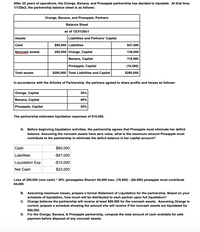
FINANCIAL ACCOUNTING
10th Edition
ISBN: 9781259964947
Author: Libby
Publisher: MCG
expand_more
expand_more
format_list_bulleted
Concept explainers
Question
i started this, please help with b,c,d

Transcribed Image Text:After 25 years of operations, the Orange, Banana, and Pineapple partnership has decided to liquidate. At that time,
1/1/20x2, the partnership balance sheet is as follows:
Orange, Banana, and Pineapple, Partners
Balance Sheet
as of 12/31/20x1
Assets
Liabilities and Partners' Capital
Cash
$80,000 Liabilities
$47,000
Noncash assets
205,000 Orange, Capital
138,000
Banana, Capital
119,500
Pineapple, Capital
(19,500)
Total assets
$285,000 Total Liabilities and Capital
$285,000
In accordance with the Articles of Partnership, the partners agreed to share profits and losses as follows:
Orange, Capital
30%
Banana, Capital
40%
Pineapple, Capital
30%
The partnership estimates liquidation expenses of $10,000.
A. Before beginning liquidation activities, the partnership agrees that Pineapple must eliminate her deficit
balance. Assuming the noncash assets have zero value, what is the maximum amount Pineapple must
contribute to the partnership to eliminate the deficit balance in her capital account?
Cash
$80,000
Liabilities
-$47,000
Liquidation Exp
-$10,000
Net Cash
$23,000
Loss of 205,000 (non cash) * 30% (pineapples Share)= 64,500 loss. (19,500) - (64,500) pineapple must contribute
84,000
B. Assuming maximum losses, prepare a formal Statement of Liquidation for the partnership. Based on your
schedule of liquidation, how much will be distributed to each partner upon full liquidation?
C. Orange believes the partnership will receive at least $80,000 for the noncash assets. Assuming Orange is
correct, prepare a schedule showing the amount she will receive if the noncash assets are liquidated for
$80,000.
For the Orange, Banana, & Pineapple partnership, compute the total amount of cash available for safe
payment before disposal of any noncash assets.
D.
Expert Solution
This question has been solved!
Explore an expertly crafted, step-by-step solution for a thorough understanding of key concepts.
This is a popular solution
Trending nowThis is a popular solution!
Step by stepSolved in 2 steps with 6 images

Knowledge Booster
Learn more about
Need a deep-dive on the concept behind this application? Look no further. Learn more about this topic, accounting and related others by exploring similar questions and additional content below.Similar questions
- Required information [The following information applies to the questions displayed below.] Consider the following narrative describing the process of filling a customer's order at a Starbucks branch: Identify the start and end events and the activities in the following narrative, and then draw the business process model using BPMN: the Starbucks customer entered the drive-through lane and stopped to review the menu. He then ordered a Venti coffee of the day and a blueberry muffin from the barista. The barista recorded the order in the cash register. While the customer drove to the window, the barista filled a Venti cup with coffee, put a lid on it, and retrieved the muffin from the pastry case and placed it in a bag. The barista handed the bag with the muffin and the hot coffee to the customer. The customer has an option to pay with cash, credit card, or Starbucks gift card. The customer paid with a gift card. The barista recorded the payment and returned the card along with the…arrow_forwardWould you please provide the answer for #4 as well? Thank you!arrow_forwardPLEASE EXPLAIN EACH POINT STEP BY STEParrow_forward
- Can you please solve questions 5-15 of the problem above. Thank you.arrow_forwardYou guys provided me an expert answer? Cuz the table for the part 1 of the p missing as well on volum PR what do i enter? and the part 2 has a table but c utilized.arrow_forwardHi can you show how to input in excel using the pmt formula thank you so mucharrow_forward
arrow_back_ios
arrow_forward_ios
Recommended textbooks for you

 AccountingAccountingISBN:9781337272094Author:WARREN, Carl S., Reeve, James M., Duchac, Jonathan E.Publisher:Cengage Learning,
AccountingAccountingISBN:9781337272094Author:WARREN, Carl S., Reeve, James M., Duchac, Jonathan E.Publisher:Cengage Learning, Accounting Information SystemsAccountingISBN:9781337619202Author:Hall, James A.Publisher:Cengage Learning,
Accounting Information SystemsAccountingISBN:9781337619202Author:Hall, James A.Publisher:Cengage Learning, Horngren's Cost Accounting: A Managerial Emphasis...AccountingISBN:9780134475585Author:Srikant M. Datar, Madhav V. RajanPublisher:PEARSON
Horngren's Cost Accounting: A Managerial Emphasis...AccountingISBN:9780134475585Author:Srikant M. Datar, Madhav V. RajanPublisher:PEARSON Intermediate AccountingAccountingISBN:9781259722660Author:J. David Spiceland, Mark W. Nelson, Wayne M ThomasPublisher:McGraw-Hill Education
Intermediate AccountingAccountingISBN:9781259722660Author:J. David Spiceland, Mark W. Nelson, Wayne M ThomasPublisher:McGraw-Hill Education Financial and Managerial AccountingAccountingISBN:9781259726705Author:John J Wild, Ken W. Shaw, Barbara Chiappetta Fundamental Accounting PrinciplesPublisher:McGraw-Hill Education
Financial and Managerial AccountingAccountingISBN:9781259726705Author:John J Wild, Ken W. Shaw, Barbara Chiappetta Fundamental Accounting PrinciplesPublisher:McGraw-Hill Education


Accounting
Accounting
ISBN:9781337272094
Author:WARREN, Carl S., Reeve, James M., Duchac, Jonathan E.
Publisher:Cengage Learning,

Accounting Information Systems
Accounting
ISBN:9781337619202
Author:Hall, James A.
Publisher:Cengage Learning,

Horngren's Cost Accounting: A Managerial Emphasis...
Accounting
ISBN:9780134475585
Author:Srikant M. Datar, Madhav V. Rajan
Publisher:PEARSON

Intermediate Accounting
Accounting
ISBN:9781259722660
Author:J. David Spiceland, Mark W. Nelson, Wayne M Thomas
Publisher:McGraw-Hill Education

Financial and Managerial Accounting
Accounting
ISBN:9781259726705
Author:John J Wild, Ken W. Shaw, Barbara Chiappetta Fundamental Accounting Principles
Publisher:McGraw-Hill Education